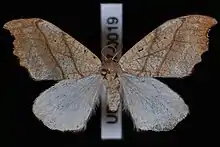| Falcaria bilineata | |
|---|---|
 | |
| Scientific classification | |
| Domain: | Eukaryota |
| Kingdom: | Animalia |
| Phylum: | Arthropoda |
| Class: | Insecta |
| Order: | Lepidoptera |
| Family: | Drepanidae |
| Genus: | Falcaria |
| Species: | F. bilineata |
| Binomial name | |
| Falcaria bilineata (Packard, 1864) | |
| Synonyms | |
| |
Falcaria bilineata, the two-lined hooktip moth, is a moth in the family Drepanidae. It was described by Packard in 1864.[1] It is found in North America, where it has been recorded from Newfoundland to New Jersey, west to Oregon and north to British Columbia.[2] The habitat consists of deciduous woodlands.
The wingspan is 28–33 mm. The forewings are light brown to orangish-yellow. The ante- and postmedial lines are brown, straight and parallel and the reniform spot has the form of a black dot. The hindwings are white or pale yellow with a small indistinct discal spot and a thin brown terminal line. Adults are on wing from April to September in two generations per year.[3]
The larvae feed on the leaves of Alnus and Betula species.[4] The larva have a purplish or reddish-brown body, mottled with yellow. Pupation takes place in a cocoon made within a folded leaf.
Subspecies
- Falcaria bilineata bilineata
- Falcaria bilineata rampartensis (Barnes & Benjamin, 1922)
References
- ↑ Beccaloni, G.; Scoble, M.; Kitching, I.; Simonsen, T.; Robinson, G.; Pitkin, B.; Hine, A.; Lyal, C., eds. (2003). "Falcaria bilineata". The Global Lepidoptera Names Index. Natural History Museum. Retrieved May 24, 2018.
- ↑ mothphotographersgroup
- ↑ Bug Guide
- ↑ Pacific Northwest Moths